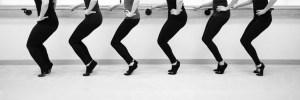Are your hips fit? Our hips are the body’s largest joints and are vital to everyday movement. As physiotherapists, we see more and more clients these days suffering from mild to severe osteoarthritis in their hips, which in many cases, leads to the necessity of major hip replacement surgery. One of our roles as practitioners who see a lot of people with these issues is prevention. The good news is that you can learn how to look after your joints so that they remain healthy, strong and flexible for your lifetime.
Healthy hips are important at any age, and it’s best to start out early in learning how to prevent problems. Weakness and/or tightness in the muscles around the hip promotes inflexibility and lack of movement in this ball and socket joint. When the joint fails to move properly the bone starts to present with degenerative changes. Furthermore, improper mechanics at the hip joint can lead to all kinds of secondary problems in the knee, back and feet.
There are a few components to attaining fit hips: flexibility/range of motion, strength and movement.
Flexibility.
First of all, it is important to maintain proper hip range motion. Most people don’t actually move their hips through the full range of motion that the hip is supposed to go! Whether you are a desk jockey, weekend warrior, or high-level athlete, your activity doesn’t always promote full normal motion in the joint. For example, if you have a sedentary lifestyle, you spend a lot of your time with your hips flexed. You aren’t likely your hip joint into the opposite fully extended position very often. This not only can lead to movement impairments but also lead to injuries/pain in our knees, sacroiliac joint and most often lumbar spine.
Incorporate these 5 relatively simple stretches into your day that will effectively increase your hip mobility. The best results come from staying consistent and being persistent! This means you should be doing them at least 3 days a week. You should also aim to hold each stretch for at least 30 seconds and repeat 2-3 times per side.
- Hip flexor Stretch: This group of muscles sits in front of your hip. To stretch your left hip: position your left knee slightly behind your left hip. Keep your shoulders above your hips and then focus on a posterior pelvic tilt. Lean forward until a stretch is felt in front of your hip.
- Hip extensor/hamstring stretch**: This group of muscles sits behind the hip; lying on the ground bring one straight leg towards you; the knee can be straight or bent (a little or a lot) depending on where you want the stretch to focus.
** People with any sciatic nerve problems should avoid this stretch unless they have had some advice given from a physiotherapist
- Hip adductor Stretch 1: Sitting with a straight back and with soles of feet touching, gently push down on your knees.
- Hip adductor/inner thigh stretch 2: In a four-point kneeling position spread your knees apart to a comfortable distance and hold the stretch.
- Hip rotator stretch: These muscles work to rotate our hip either inwards or outwards; to stretch your left hip, sitting, place your right ankle onto your left knee and lean forward
Strength.
The second key factor in optimal hip health is strength. Try these two tests to determine if your hip muscles need a little work!
TWO QUKCK TESTS FOR HIP STRENGTH
Test 1: One-Legged–Bridge
Lie on the ground with your knees bent. Lift your butt up off the ground and then raise one leg off the ground slowly. Your pelvis should stay perfectly level as you raise this leg. If it tilts to one side, you likely have some weakness in your core and glute muscles.
Test 2: Single Leg Squats
The second test evaluates the coordination of your hip stabilizer muscles during dynamic activity. For this test, simply do five or 10 single-leg squats, being sure to keep your torso upright and your knee about even with your toes.
While you are doing these squats, glance down at your knee. Is it pointing straight ahead, or is it buckled or rotated inward? If your hip stabilizers are weak, or if they simply aren’t very well-coordinated, you’ll find these single-leg squats quite difficult to do without allowing your knee to wobble around or buckle inward.
What’s the evidence?
Biomechanical research has correlated faulty mechanical motions observed in poorly done single-leg squats (which allows excessive internal rotation and hip adduction) with knee injuries. So if your hip stabilizing muscles are weak, studies have shown that this can be associated with conditions like patellofemoral pain or IT band syndrome.
Likewise, with a one-leg glut bridge, if there is an inability to maintain a level pelvis while on one leg, this demonstrates a lack of strength in your hip abductors and external rotators. Lack of strength in these muscles promotes faulty gait patterns which can again lead to knee, hip and back secondary conditions.
Movement.
Lastly, joints need to move. Just like the chain on your bike which gets rusty if you don’t ride it, the hip needs movement to provide nourishment and lubrication of its surfaces. Our joints are lined with cartilage that doesn’t have a good blood supply. To get nutrition into the cells of the joint surface, movement and compression (i.e. in weight-bearing and gait) are crucial. A rusty “chain” leads to arthritic and degenerative changes in the joint. Walking is a simple, yet effective way to get those hips lubricated.
Need some help with your hips? If you are unsure about your hip health, strength, or mobility, a thorough assessment by a physiotherapist is the next best step!
Services Offered:
Acupuncture
Dry Needling
Intramuscular Stimulation (IMS)
Physiotherapy
Virtual Physiotherapy






